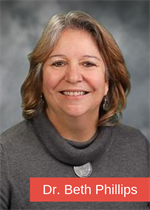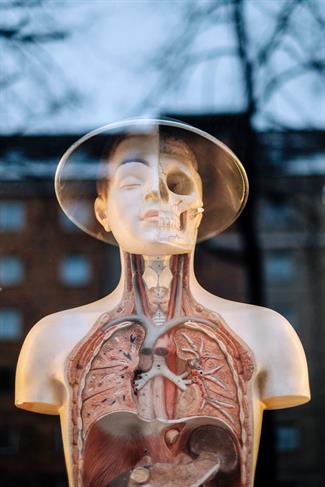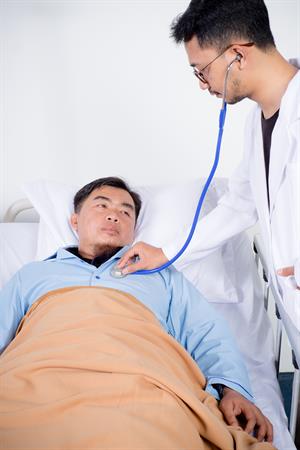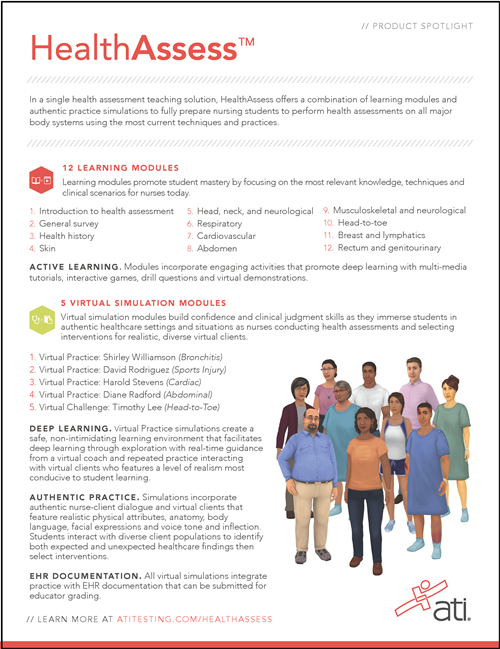6 TIPS TO TEACH HEALTH ASSESSMENT IN THE CLASSROOM
Aug 19, 2021, 15:53 PM
<8-min. read> Students need a strong foundation in performing health assessments before they ever step foot in a clinical setting. Building that base starts in the classroom.

 Seeing into the future isn’t one of the skills required to be a successful nurse educator. But it’s one that seems to have been developed by Beth Phillips, PhD, RN, CNE, ATI Strategic Nursing Advisor (and former associate professor in the School of Nursing at Duke University and director of the Institute of Educational Excellence).
Seeing into the future isn’t one of the skills required to be a successful nurse educator. But it’s one that seems to have been developed by Beth Phillips, PhD, RN, CNE, ATI Strategic Nursing Advisor (and former associate professor in the School of Nursing at Duke University and director of the Institute of Educational Excellence).
About 13 years ago, long before Dr. Phillips began working at ATI, she received a national grant to develop a virtual lab environment on a gaming platform. While that concept is commonplace in today’s tech world, in 2009 and ‘10, the experience was mostly reserved for retail game consoles like PlayStation, Genesis, and Xbox.
“I was very intrigued by the whole process of virtual worlds,” Dr. Phillips explained. She hired a developer and got as far as a usability study before — no surprise — she ran out of funding.
Not wanting to give up on her idea of developing a simulated clinical experience, she approached some team members at ATI.
“They were very intrigued by it. But I think I was a little ahead of the curve,” she explained, adding that the technology then had not advanced to where it is today. “And it was very, very expensive,” she added. “They were gracious to me, but we put it on the backburner.”
Fast forward a decade.
“A little bit over 3 years ago, while I was still at Duke, I was talking with some of the folks at ATI and, again, the issue came up about a virtual environment,” she said. “I was asked if I still had an interest in that. They didn’t have to ask me twice,” she added.
Dr. Phillips said she saw great merit in nursing education for a simulated health assessment offering. “I could really see it enhancing our student learning.” So she signed up to be part of an ATI product development team and began meeting weekly to work on the creation of a new virtual health assessment simulation resource.
“I think the students of today are really, really involved with online platforms — activities that they can do with mobile, and all of those kinds of things. And this fits right in with that beautifully,” she added. “There’s lots of gaming going on, and the students are very much into that kind of environment. So, this helps to meet some of those needs. And yet there’s so much learning embedded in every step along the process.”
The product — ATI’s HealthAssess simulation tool, which acts as a simple, single solution to teaching health assessment — launched about 3 years ago, and Dr. Phillips continued to be involved throughout her tenure at Duke. (She went on to help determine how to embed electronic health records into the platform.)
In the meantime, educators who want to get on the cutting edge of teaching health assessment skills in the classroom can take advantage of the tool’s first phase. And Dr. Phillips offers up some tips you can implement to make the use of this innovative resource as meaningful and impactful as possible.
Tip 1: Familiarize yourself with the learning opportunities with simulated health assessment.
 Dr. Phillips explained that the modules in HealthAssess include interactive learning, virtual demonstrations, virtual practice opportunities, and virtual challenges (head-to-toe assessments).
Dr. Phillips explained that the modules in HealthAssess include interactive learning, virtual demonstrations, virtual practice opportunities, and virtual challenges (head-to-toe assessments). “Students can learn, go into didactic, and read about the anatomy and physiology of a system,” she said.
HealthAssess’s first phase provides modules for each basic body systems. “We wanted to cover the lungs and the heart and the musculoskeletal, the G.I. system, the skin,” she added. “Those modules really help students learn those skills.”
Other modules in the resource include patient scenarios. “We built patient scenarios that have some abnormalities, some unexpected findings or illnesses that the students will uncover as they care for the patient,” she said.
Each of the scenarios involves more than one body system. “That’s very realistic to what we find in the healthcare system. Very infrequently these days do people just have one thing wrong with them. There are usually several things. And so we designed modules based on common illnesses and findings that we see and things that we know the students need to be able to recognize, like the irregular heartbeat or a swollen limb.”
Tip 2: Understand the benefits. (Hint: Simulated health assessment saves time and energy.)
 A benefit Dr. Phillips thinks students especially appreciate is the ability to use the tool anywhere that they have an Internet connection. “They can practice as if they’re going into a lab, and they can do it from home or the bus or wherever they are.”
A benefit Dr. Phillips thinks students especially appreciate is the ability to use the tool anywhere that they have an Internet connection. “They can practice as if they’re going into a lab, and they can do it from home or the bus or wherever they are.”This ease of access not only saves students time and energy, but faculty, as well.
“Faculty find that this product is something that really enhances student learning and saves them time in the class,” Dr. Phillips explained.
Prewritten lesson plans included with HealthAssess, for example, make it easy for faculty to integrate simulations into their curricula.
Plus, Dr. Phillips noted, the options of how to integrate the assessments are only as limited as a faculty member’s imagination. “They can use a format of case studies or do something else creative in class instead of going system by system and teaching those things to the students,” she said.
“In the end, the students will be stronger for it, because they’ve actually had that practice.”
Tip 3: Stress the value of consistency within simulated health-assessment teaching.
 Dr. Phillips describes HealthAssess as a multifaceted product that serves many purposes for nursing education. “Students can strengthen their health-assessment skills for sure,” she said. “That’s the No. 1 reason why it was developed. However, there are so many other things embedded in the modules.”
Dr. Phillips describes HealthAssess as a multifaceted product that serves many purposes for nursing education. “Students can strengthen their health-assessment skills for sure,” she said. “That’s the No. 1 reason why it was developed. However, there are so many other things embedded in the modules.” Chief among them is the ability to deliver consistent experiences. That’s crucial because no clinical experience is the same; faculty have no control over what students encounter.
“We are really at the mercy of the patients that are there during clinicals,” Dr. Phillips said. “Students may not see a patient, for example, with an irregular heart rate. But, with simulation and with this format of virtual environments, we can create and provide consistent experiences.”
Those experiences include reviewing patient histories, communicating with patients, and reviewing provider orders, Dr. Phillips added. “Students can really make connections between problems patients are having with what’s ordered and then what they’re going to do about it.”
Those connections help build clinical judgment and decision-making.
“Students really are formulating a plan of care, which is a huge piece of what we teach students to do, all within this virtual environment where they’re able to connect a patient that’s laying down in bed, for example, is short of breath, because they’re very obese, and they need to sit up, so that their lungs can expand to full capacity.”
One other benefit? Faculty gain the advantage of having uniform opportunities to provide feedback to students. “It evens the playing field, if you want to think of it that way,” Dr. Phillips said.
Tip 4: Look at your program’s structure to identify how to incorporate the health-assessment tool.
Dr. Phillips offered several suggestions as to the best time to use HealthAssess in a curriculum.“I think HealthAssess can be placed within the curriculum in a variety of different ways depending upon the way the structure is of the curriculum. For example, at my school, we had health assessment and foundations in the very first semester. So, I used it in week three of the semester and then continued it throughout that semester.”
She added, “As more modules are added, educators can intersperse the tool throughout the curriculum. A 4-year program may use it in their sophomore or junior year where the students learn foundational skills.”
Tip 5: Don’t miss other uses for simulated health assessment, such as remediation.
 Dr. Phillips identifies multiple opportunities for HealthAssess to assist students needing more experience in certain areas.
Dr. Phillips identifies multiple opportunities for HealthAssess to assist students needing more experience in certain areas. “I suggest using it for remediation if a student gets into the clinical setting and maybe they’re not quite where they need to be on a particular assessment,” she explained. “They forget where to listen to heart sounds, or they forget how to find all the pulses in the body. They can be sent back to remediate on that particular module.”
Then, the student can use the tool to demonstrate to his or her instructor that they have fully developed the skill to return to clinical.
Tip 6: Help naysayers understand how “real” virtual health assessment is.
Those who haven’t experienced virtual simulations may scoff at how realistic the experiences can be. But Dr. Phillips said simulation could be as powerful as real-life clinical.“I’ve personally experienced, in virtual environments, feeling nervous that my patient was going to crump on me or was going to stop breathing. I’ve seen in my previous work — my usability study — that when those students saw the patient wasn’t doing well, they had a visceral reaction to it, even though it was on a computer screen.”
Learning in a virtual environment, then, can be truly impactful “I know that simulation can affect students’ processes and how they make decisions later in their career. So the sky’s the limit with how much learning can happen in this environment, and I think educators should welcome it and be open to it,” she added.

